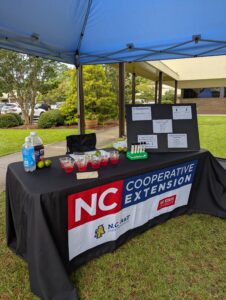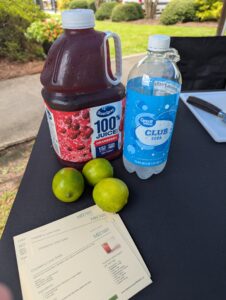Added Sugars
go.ncsu.edu/readext?1086535
en Español / em Português
El inglés es el idioma de control de esta página. En la medida en que haya algún conflicto entre la traducción al inglés y la traducción, el inglés prevalece.
Al hacer clic en el enlace de traducción se activa un servicio de traducción gratuito para convertir la página al español. Al igual que con cualquier traducción por Internet, la conversión no es sensible al contexto y puede que no traduzca el texto en su significado original. NC State Extension no garantiza la exactitud del texto traducido. Por favor, tenga en cuenta que algunas aplicaciones y/o servicios pueden no funcionar como se espera cuando se traducen.
Português
Inglês é o idioma de controle desta página. Na medida que haja algum conflito entre o texto original em Inglês e a tradução, o Inglês prevalece.
Ao clicar no link de tradução, um serviço gratuito de tradução será ativado para converter a página para o Português. Como em qualquer tradução pela internet, a conversão não é sensivel ao contexto e pode não ocorrer a tradução para o significado orginal. O serviço de Extensão da Carolina do Norte (NC State Extension) não garante a exatidão do texto traduzido. Por favor, observe que algumas funções ou serviços podem não funcionar como esperado após a tradução.
English
English is the controlling language of this page. To the extent there is any conflict between the English text and the translation, English controls.
Clicking on the translation link activates a free translation service to convert the page to Spanish. As with any Internet translation, the conversion is not context-sensitive and may not translate the text to its original meaning. NC State Extension does not guarantee the accuracy of the translated text. Please note that some applications and/or services may not function as expected when translated.
Collapse ▲
Earlier this month our N.C. Cooperative Extension office participated in the annual
Brunswick County Health and Wellness Fair at the Government Complex in Bolivia.
There were exhibits from local businesses and organizations as well as fitness
demonstrations and health screenings.
Our Family and Consumer Sciences team staffed an exhibit which looked at added sugars in our diets. In general, American’s consume too much added sugar. This excess sugar can lead to health problems including weight gain, obesity, type 2 diabetes, heart disease and cavities.
Think you don’t get that much? It’s estimated that on an average day, adult men consume 19 teaspoons and adult women consume 15 teaspoons of added sugars. So, you may ask, how much sugar am I supposed to have every day? I’m talking added sugars here—not the kind of sugar that’s naturally in food like fruits, vegetables and milk. Added sugars are those found in beverages, sweets, snacks, condiments, sauces and processed foods. Luckily, food labels now tell us the difference between natural sugars and added sugar.
You really don’t need any added sugars each day. The Dietary Guidelines for Americans 2020–2025 recommend that people age 2 years or older limit added sugars intake to less than 10% of their total daily calories. That means for a 2,000-calorie diet, no more than 200 calories should come from added sugars. That’s about 12 teaspoons of added sugar from both food and beverages a day (that’s less than in one 20-ounce soda). An added note: children younger than 2 years should not be given any foods or beverages with added sugars.
Sugary drinks are the number one source of added sugars in the American diet. Drinks with added sugars include sodas, fruit drinks, sweetened teas, flavored coffees, flavored waters, chocolate milk, sports drinks and energy drinks. Here are a few examples of the amount of added sugar in 12-ounce beverages:
Brewed sweet tea = 7 teaspoons
Energy drink = 9 teaspoons
Regular soda = 10 teaspoons
So, what can you do to rethink your drink? Here are a couple of suggestions:
- Choose water, when possible, instead of sugary drink. This can be tap water or
unsweetened, bottled water or sparkling water. Need more flavor? Add berries or slices of lime, lemon or cucumber to the water. - Read labels to see how much added sugar is in the drinks you choose.
You really want a fizzy drink? Add a splash of 100% fruit juice to plain sparkling water for a bubbly, low-calorie drink. - Need help breaking the soda or iced tea habit? Don’t stock up on sugar drinks. Instead, keep a jug or reusable bottles of cold water in the fridge and carry a reusable water bottle with you and refill it throughout the day.

We wanted to share a refreshing alternative to sugary sodas at the Health and Wellness Fair. So, we provided samples of a Cranberry Lime Soda from our “Med Instead of Meds” recipe library. Here’s the recipe to try yourself.
Cranberry Lime Soda
- cup cranberry juice (100% juice, no sugar added)
- cup club soda
- 1 lime slice
Combine cranberry juice and club soda. Garnish with by squeezing a lime slice.
The drink got good reviews. There were lots of questions about using the fruit juice due to its natural sugar calories. We did use 100% cranberry juice not a juice blend or a juice cocktail. By adding the club soda, we reduced the calories and got a nice fizz with only about 31 calories per cup. These calories were from the natural sugar in the
cranberries. There is no added sugar in this recipe and cranberries are high in vitamin
C…so you get a little nutrition, too.
The “Med Instead of Meds” website has several other recipes for low sugar drink ideas including Strawberry Mint Water, Ginger Green Tea and Cucumber Citrus Water. The website also contains a series of videos on the Mediterranean Diet and how to make other healthy changes to your diet.
The county’s office of Risk Management is already planning for next year’s Health and Wellness Fair—be looking for the dates.
Syracuse is a Family and Consumer Science team member and can be reached at NC
Cooperative Extension, Brunswick County Center 910-253-2610 or by email at
clsyracu@ncsu.edu



